
Kalman Tihanyi (1897 - 1947)
Automatic Sighting and Directing Devices for
Torpedos,
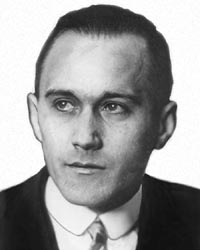
Kalman Tihanyi www.hpo.hu which says in part.. "...From 1929, he [Tihanyi] worked on television-guidance for defense, building prototypes of his robot aircraft in London for the British Air Ministry, later adapting it for the Italian Navy."
December 7, 2002 Dear Dr. Naughton, Attached is a selection from the documents related to Kalman Tihanyi's "Aerial Torpedo" and its development 1929 to 1934. The full collection, including my father's correspondence with his family and especially with those of his brothers who collaborated on his projects, provide reliable information into his activities and the events taking place during these years. Indeed, what we are dealing with in this case is an embarrassment of riches. Tihanyi left behind a huge amount of documents, most of which are deposited at the Hungarian Academy of Sciences' Manuscript Library. These include notebooks and manuscripts of inventions 1910-- when Tihanyi was merely thirteen-year-old!--through 1947, private and business correspondence, contracts, as well as literary material and music written by him. Additional manuscripts, photos, a collection of science books, some containing annotations made by him, as well as correspondence regarding his television projects and his last significant, nearly finished invention development remain for the time being in my personal archives. To this legacy I added a substantial amount of material of my own research. A few remarks regarding the attached items: Although photos exist showing Tihanyi inside the air ministry labs, these are not of the best quality. Thus I decided to send two press photos I have recently discovered at the Hungarian National Museum's Photo Archives, so these should be credited curtesy of the Museum. The portrait is from February 1932, taken in Genoa, Italy (see article from Az Est), while the full figure photo, apparently part of another article, was taken in London, most likely in 1930. Several articles about this project appeared in Hungarian newspapers, one or two were published in Italy, and two German articles about Tihanyi's television work mention this project as well, yet none was published about it in Great Britain. The letter from the Daily Mail explains the reason for this. The letter by Lt. Col. Wesson, asst. military attache to the U.S., was followed by several others. Apparently, Lt. Col. Wesson received a "description and five sketches of the optical self-directing apparatus", which he then forwarded to the War Department and which, per subsequent letters of April-May 1933 by the naval attache, ended up "interesting" the U.S. Navy Department. Tihanyi received a request for detailed plans and a proposal; the letter stated that these would be kept confidential and no use would be made of them without first informing him....The proposal was apparently submitted. By the way, in 1931, Tihanyi filed a new patent application for the improved version of this invention, which according to a letter home he considered "the really good solution". Regarding the letter from Colonel Kittoe: "the Secretary" (of Air) was Lord Thomson. The Capt. Falkner (sic) mentioned by Kittoe apparently represented Tihanyi in his dealings with the ministry. I believe he could be identical with the Capt. Faulkner (sic) who was later a member of the so-called Tizard Commission (see David Zimmerman, Top Secret Exchange: The Tizard Mission and the Scientific War, Mc Gill - Queens University Press, 1996). Best regards, Katalin Tihanyi Glass
also... In an article, entitled, "Etwas uber das Fernsehen," ("About television,") written by Kalman Tihanyi and published in the journal: Funkstunde, Berlin, (undated, but judging from reference to the 1929 invitation by the British Air Ministry to London, probably in early 1930) Tihanyi describes his Aerial Torpedo as a device which also possesses "eyes" with the help of which it "sees" and locks onto moving targets deploying one of various weapons it carries for the target's destruction. It should be noted that the patent [K. Tihanyi: Br. Pat. 352.035/December 21, 1929 application, (conv. date December 16, 1929, Hungary), issued June 22, 1931.] describes television guidance through specially constructed light and heat sensitive photocells for other types of weaponry, such as tanks, bombs, etc. as well.
Gallery Images, Letters and News Cuttings related to Kalman Tihanyi's Patent of Dec. 16, 1929 for an Automatic Sighting and Directing Devices for Torpedos, Guns and other Apparatus - Click on images to see larger, readable copies.
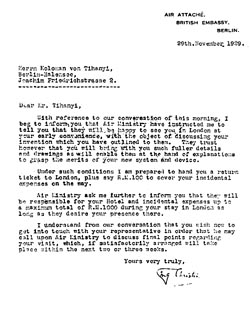 Letter from the British Embassy, Nov. 29, 1929
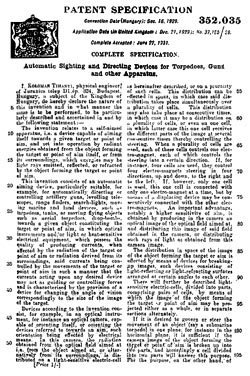
British Pat. 352.035, Dec. 21, 1929, page 1,
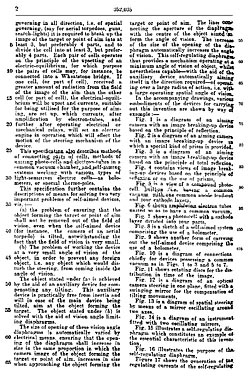
British Pat. 352.035, Dec. 21, 1929, page 2,
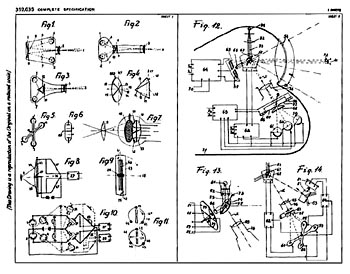
Drawing of British Pat. 352.035, Dec. 21, 1929, page 7,
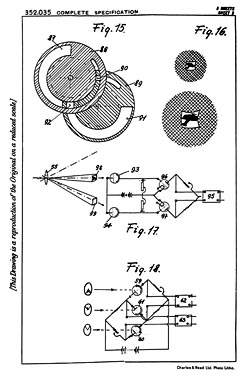
Drawing of British Pat. 352.035, Dec. 21, 1929, page 8,
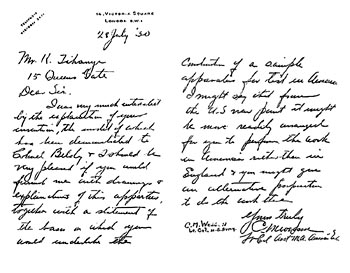 Letter from Lt. Col. C.M. Wesson, Asst. M.A. American Embassy, Jul. 28, 1930
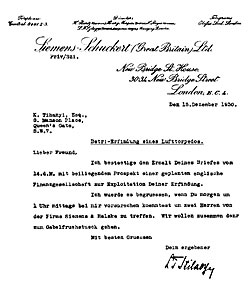 Letter from L.F. Szilagyi, December 14, 1930
Translation
December 14, 1930 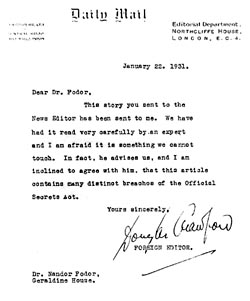 Letter from the Daily Mail to Dr Nandor Fodor, Jan. 22, 1931
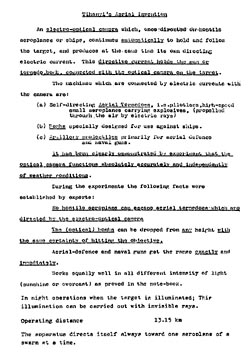 A short expose of the invention
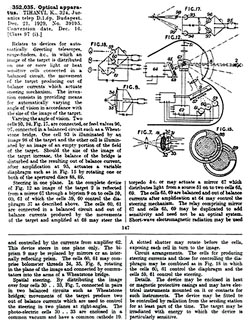 Patent 352.035, Abstract Official Journal, Patents.
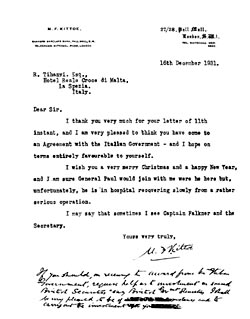 Letter from Col. M.F. Kittoe, Dec. 16, 1931 Received by Kalman Tihanyi shortly after his arrival in Italy
 Article by the Geneva-correspondent for Az Est, Feb.19, 1932
"The invention of the Hungarian engineer, Kalman Tihanyi
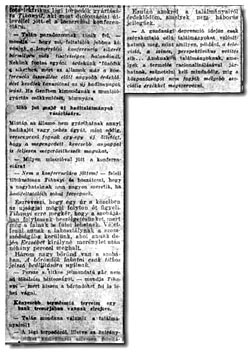 Article (cont.), Feb.19, 1932 Geneva-correspondent for Az Est, Feb.19, 1932
 Letter from Patent Attorney Eng. B. Zanardo, Dec. 31, 1932
transl: "Count Elia requests that you notify him by cable
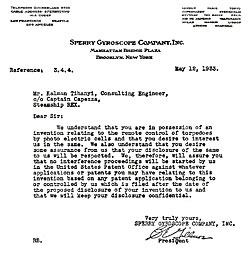 Letter from "Sperry Gyroscope Co. Inc.", May 12, 1933
Katalin Tihanyi notes : As evidenced by this letter and the note from Mr. Szilagyi of Siemens-Schuckert, Tihanyi initiated negotiations in several directions. The letter from the president of Sperry Gyroscope, one of the most important manufacturers of electronic military equipment, suggests a keen interest in the invention. It is namely quite unusual to elicit an agreement of the kind given here. The U.S. Navy's interest at this time was not so much in the opportunity offered to them by Tihanyi to inspect the working model of the camera as in eliciting "detailed plans" and "acceptable" conditions. A letter by the U.S. military attaché to Rome confirms the receipt and relay to the Navy of Tihanyi's May 18, 1933 reply, but, naturally, reveals no information as to its content. 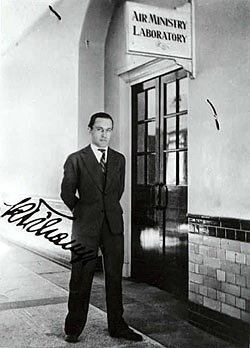 Kalman Tihanyi, London, 1930
Kalman Tihanyi and his Prime Invention, All-Electronic Storage-Type Image Transmission and Reception
"The Iconoscope and the Development of Modern Television" Kalman Tihanyi's daughter Katalin presents a comprehensive look at this pioneer inventor. The article was first published in Technikatorteneti Szemle XX (1993) 173-199, the journal of the Hungarian Museum of Technology
Kalman Tihanyi, 1926 Patent Application "Radioskop" Preamble In 2001 Kalman Tihanyi's original 1926 patent application in which he laid down the fundaments of all-electronic storage-type television was inscribed on UNESCO's Memory of the World Register, similar in some ways to the World Heritage List. The Memory of the World Register lists documentary heritage which has been identified by the Memory of the World International Committee as meeting the selection criteria for world significance. According to the first of the seven major and two minor criteria a document has to pass "Documentary heritage is of worldwide significance if it has had a major influence on the history of the world, transcending the boundaries of national culture." Katalin Tihanyi Glass
Introduction The television system, which in the wake of the publication of Kalman Tihanyi's French and British patents of 1928 priority gave new direction to television development, is recognized by historiography as one of the great inventions of the 20th century. This invention, the last of the three "evolutionary leaps" discernible within the developmental history of television, made possible its technical realization and industrial mass-production.
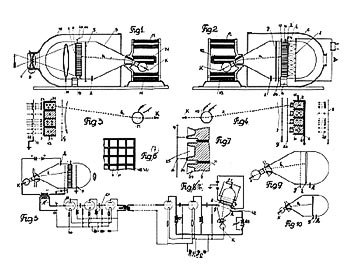 Kalman Tihanyi's 1926 Patent Application "Radioskop" See the complete "Radioskop" Patent
The documentary heritage is the first description by the inventor of his television system, and the only existing complete collection of documents representing the Hungarian patent applications he filed in 1926 under the name "Radioskop". The significance of this document, then, resides in the fact that it is here the inventor first laid out the fundaments of modern television featuring a fully electronic television transmitting and receiving system and introducing, among many novel features, the operating principle of accumulation and "storage" of electrical Charges throughout each scansion cycle.
Abstract The television system, which in the wake of the publication of Kalman Tihanyi's French and British patents of 1928 priority gave new direction to television development, is recognized by historiography as one of the great inventions of the 20th century. This invention, the last of the three "evolutionary leaps" discernible within the developmental history of television, made possible its technical realization and industrial mass-production. The documentary heritage is the first description by the inventor of his television system, and the only existing complete collection of documents representing the Hungarian patent applications he filed in 1926 under the name "Radioskop". The significance of this document, then, resides in the fact that it is here the inventor first laid out the fundaments of modern television featuring a fully electronic television transmitting and receiving system and introducing, among many novel features, the operating principle of accumulation and "storage" of electrical Charges throughout each scansion cycle. This is the only existing complete collection of documents representing the Hungarian patent applications he filed in 1926 under the name "Radioskop". The significance of this document laid out the fundaments of modern television featuring a fully electronic television transmitting and receiving system and introducing, among many novel features, the operating principle of accumulation and "storage" of electrical Charges throughout each scansion cycle....more
Kalman Tihanyi Kalman Tihanyi, a physicist, applied for a patent on storing charges for improving the light sensitivity of television recording systems on 20 March, 1926. His transmission-receiver system was named the Radioscope. He described several practical solutions for the picture tube and for the recording device in his principal patent registered in Hungary, Germany, England, France and America. RCA purchased his patents, which were the basis of the iconoscope, developed later by Zworykin and his associates at RCA. This device was manufactured from 1930 on for transmitting television programmes. Charge-storage has remained the basic principle of modern television. Tihanyi also developed a special, infrared-sensitive (night) television camera, which was patented for the control of airplanes and military vehicles in 1929. In 1939 he submitted a patent application in England for the flat TV tube.
Tihanyi in his true light The world's first successful all-electronic television system has long been ascribed to Vladimir Zworykin, from 1911-12 a pupil of television pioneer Boris Rosing in St Petersburg and from 1930-1932 leader of RCA's television development laboratory. It was he who in 1935 turned the Iconoscope image pickup tube into a working product suitable for series production. It is now clear, however, that the Iconoscope was not RCA's unaided work. In fact it fell to a Hungarian, Kalman (Coloman) Tihanyi, to first patent the concept of a light-sensitive image storage tube in 1928, at a time when Zworykin had already abandoned electronic pickup tubes and returned to mechanical scanning. Thanks to diligent work lasting two decades by Tihanyi's daughter, Katalin Tihanyi Glass and publicity by German researcher Antje Grabenhorst, Tihanyi is now belatedly acknowledged as the forgotten inventor of the Iconoscope. Records indicate that RCA dealt with him over the period 1930-1935 in connection with the purchase of his patents (see panel below), although the company never acknowledged that Zworykin was unable to make his camera work without external assistance. ... The Hungarian Kalman Tihanyi was a prolific inventor, who following studies in electrical engineering and physics sold several designs to RCA and the German companies Loewe and Fernseh AG. His fully electronic television system was patented in 1926 and though superficially similar to other proposals, it represented a radical departure. Like the final, improved version he patented two years later in 1928, it embodied a new concept in design and operation, building upon a phenomenon that would become known as the "storage principle". The invention was received with enthusiasm by Telefunken and Siemens, but in the end they opted for continued development of mechanical television. RCA approached Tihanyi in 1930, after the publication of his patents in England and France. Negotiations continued until 1934, when RCA, ready to unveil its new television system based on Tihanyi's design, purchased his patents. These covered key design features that caused the U.S. patent examiners, citing Tihanyi's prior publications, to deny Zworykin's 1930-31 applications. U. S. patents assigned to RCA were issued to Tihanyi in 1938-39 with 1928 priority. Now it is becoming increasingly obvious that the originator of this pivotal invention was Kalman Tihanyi. A detailed article in English setting out Tihanyi's contribution to television as well as the various patent documents can be found on the Hungarian Patent Office website at www.mszh.hu/English/feltalalok/tihanyi.html
|
© Copyright 1999-2004 CTIE - All Rights Reserved - Caution |